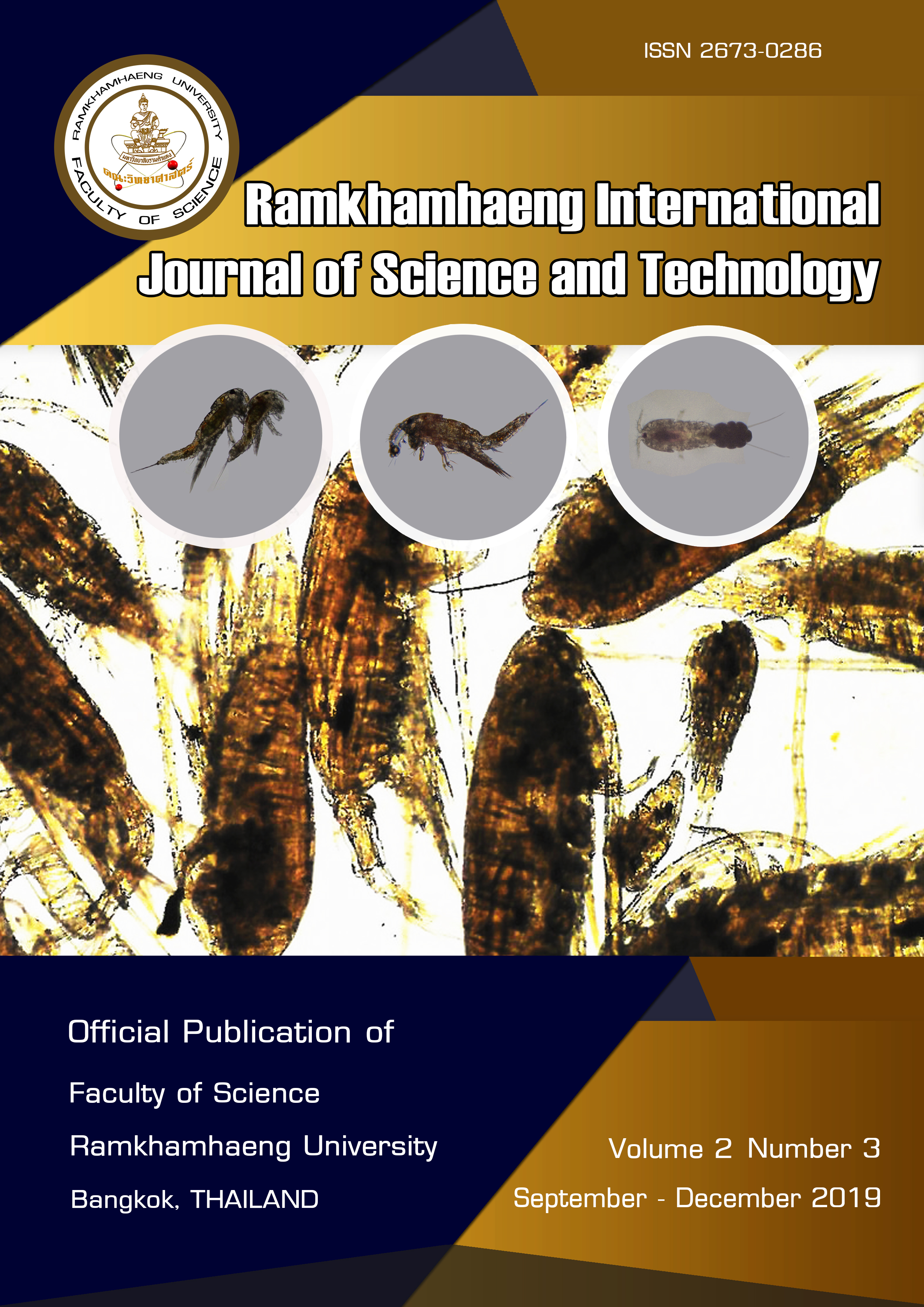Effects of salinity levels on survival rates of harpacticoid copepod Tigriopus sp. (Copepoda: Harpacticoida)
Keywords:
Tigri ous psp., culturing, salinity levels, survival rateAbstract
This research aims to study the survival rates of harpacticoid copepod Tigriopus sp. cultured at different temperatures and salinity levels. An ovigerous copepod was obtained by collecting from a brown alga, Padina sp., on Namsai sandy Beach in Chon Buri Province, Thailand, and reared at Ramkhamhaeng University. The experiment was carried out by culturing the copepods at temperatures of 25°C and 30°C, and salinity levels of 5, 10, 20, 30, 40, 45 ppt for 15 days to study the survival rate. The results showed that the temperatures and salinity levels significantly affected the survival rates of the copepods (p<0.05). The copepods cultured at the temperature of 25°C and salinity level of 30 ppt had a survival rate of 85.04%, and those cultured at the temperature of 25°C and salinity level of 20 ppt, yielded a survival rate of 82.56%. The number of survived copepods was the lowest at the salinity levels of 5 ppt and 45 ppt. It took 11 days for the copepods to develop from nauplius to adult stages, and the number of nauplii produced an average of 49±3.74.
References
Carlotti F, Paul N (1992) Model of copepod growth and development: moulting and mortality in relation to physiological processes during an individual molt cycle. Marine Ecology Progress Series 84:219-233
Chinnery FE, Williams JA (2004) The influence of temperature and salinity on Acartia (Copepoda: Calanoida) nauplii survival. Marine Biology 145(4):733-738
Chullasorn S, Ivanenko VN, Dahms HU, Kangtia P, Yang WX (2012) A new species of Tigriopus (Copepoda, Harpacticoida, Harpacticidae) from Thailand with the description of its naupliar development. Helgoland Marine Research 66:139-151
Chullasorn S, Dahms HU, Klangsin P (2013) A new species of Tigriopus (Copepoda: Harpacticoida: Harpacticidae) from Thailand with a key to the species of the genus. Journal of Natural History 47(5-12):427-447
Fleeger JW (2005) The potential to mass-culture harpacticoid copepod for use as food for larval fish. In: Lee CS, O’Beyen P, Marcus NH (2005) Copepod in aquaculture. Blackwell Publishing, Des Moines, IA
Gopakumar G, Santhosi I (2009) Use of Copepods as Live Feed for Larviculture of Damselfishes. Asian Fisheries Science 22:1- 6
Hagiwara A, Kim HJ, Matsumoto H, Ohta Y, Morita T, Hatanaka A, Ishizuka R, Sakakura Y (2017) Production and use of two marine zooplanktons, Tigriopus japonicus and Diaphanosoma celebensis, as live food for red sea bream Pagrus major larvae. Fisheries Science 82:799–809
Huys R, Gee JM, Moore CG, Hamond R (1996) Marine and brackish water harpacticoid copepods part 1. In: Kermark DM, Barnes RSK, Crothers JH (eds.) Synopses of the British Fauna (New Series). Dorset Press, Dorchester, Great Britain, pp 1-353
Ito T (1969) Descriptions and records of marine harpacticoid copepods from Hokkaido, II. Journal of the Faculty of Science, Hokkaido University 17(1):58-77
Jeyaraj N, Santhanam P, Raju P, Ananth S, Jothiraj K (2014) Alternative methods for marine harpacticoid copepod, Macrosetella gracilis production in marine fish larviculture. International Journal of Zoology Research 10(1):1-8
Miles D, Auchterlonie N, Cutts C, de Quero CM (2001) Rearing of the harpacticoid copepod Tisbe holothuriae and its application of hatchery production of atlantic halibut Hippoglossus hippoglossus. Fish Development aquaculture 23:1-41
Olivotto I, Capriotti F, Buttino I, Avella AM, Vitiello V, Maradonna V, Carnevali O (2008) The use of harpacticoid copepod as live prey for Amphiprion clarkia larviculture: Effects on larval survival and growth. Aquaculture 274:347-352
Punnarak P, Jarayabhand P, Piumsomboon A (2017) Cultivation of harpacticoid copepods (families harpacticidae and laophontidae) under selected environmental conditions. Agriculture and Natural Resources 51(4):278-285
Rhodes A (2003) Methods for high density batch culture of Nitokra lacustris, a marine harpacticoid copepod. Proceedings of the 26th Annual Larval Fish Conference: The big fish bang. Institute of Marine Research, Bergen, Norway, pp 449-465
Ruppert EE, Barnes RD (1991) Invertebrate zoology (6th ed) Saunders collage publication, New York
Santhanam P, Perumal P (2012) Feeding, survival, egg production and hatching rate of the marine copepod Oithona rigida Giesbrecht (Copepoda: Cyclopoida) under experimental conditions. Journal of the Marine Biological Association of India 54(1):38-44
Santos LS, Pastor J, Ferreira N, Costa W, Castro C, Santos PJ (2006) Developing the harpacticoid copepod Tisbe biminiensis culture: Testing for salinity tolerance, ration levels, presence of sediment and density dependent analyses. Aquaculture Research 37:1516-1523
Souissi S, Carlotti F, Nival P (1997) Food- and temperature-dependent function of moulting rate in copepods: An example of parameterization for population dynamics models. Journal of Plankton Research 19(9):1331-1346
Zaleha K, Busra I (2012) Culture of harpacticoid copepods: understanding the reproduction and effect of environmental factors: Aquaculture 343-360
Zaleha K, Farahiyah IJ (2010) Culture and Growth of a Marine Harpacticoid, Pararobertsonia sp. in Different Salinity and Temperature. Sains Malaysiana 39(1):135-140
Zaleha K, Ibrahim B, John BA, Kamaruzzaman BY (2012) Generation time of some marine harpacticoid species in laboratory condition. Journal of Biological Science 12(8):433-437
Downloads
Published
Issue
Section
License
Copyright Notice: a copyright on any article in the published journal is retained by the Ramkhamhaeng International Journal of Science and Technology. Readers or Users grant the right to use of the Article contained in the Content in accordance with the Creative Commons CC BY-NC-ND license and the Data contained in the Content in accordance with the Creative Commons CC BY-NC-ND.



